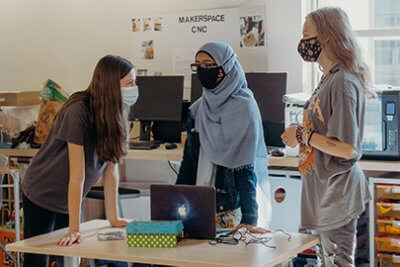May 20, 2021
 by Dr. Bill Hudson, Head of School
by Dr. Bill Hudson, Head of School
The pandemic has disrupted nearly all aspects of our lives and society. Families, civic life, the economy, and our government are just a few of the institutions that have been negatively impacted by COVID-19. At the expense of being branded “Captain Obvious,” education has also been tremendously impacted by the pandemic. Most of the conversation has been about what students have lost, and rightly so. Many educators have great concerns about a significant learning gap for students who spent the year learning remotely. Poor mental health resulting from sustained isolation is also worrisome.
While there have been losses, students have also experienced tremendous gains. Over the last year, students were confronted with numerous challenges that they had never encountered before that they needed to overcome. Students had to learn how learn remotely, to discover new ways to express themselves and their ideas, and develop a measure of autonomy, independence, and personal responsibility. They also learned how to care for themselves and overcome isolation. They learned how to push though difficulty, bounce back after failure, and try something new.
Education Week recently surveyed executives of our country’s largest companies to ask what they want and expect from today’s K-12 students. Top on their list was resilience and adaptability. Most definitions of resilience center on the ability to recover from setbacks, adapt well to change, and keep going in the face of adversity. “Encouraging and nurturing the positive elements of resilience and adaptability—inner strength, the ability to bounce back after a failure, and the courage to try something new, for example, can go a long way to prepare a student for future success in the workplace,” said Telva McGruder, chief of diversity, equity, and inclusion at General Motors.
The resilience students learned during the pandemic will serve them well in an increasingly volatile, uncertain, complex, and ambiguous world. “The ability to thrive in the face of monumental change, while maintaining some semblance of day-to-day stability both personally and professionally, requires muscle development that we often do not acknowledge until we’re faced with an adversity that demands those muscles,” reflected McGruder. “The pandemic absolutely called on each of us as individuals and as teams to focus on our ability to keep going amidst heightened ambiguity and uncertainty. There’s no doubt we are collectively going to need to keep these muscles in shape for the years to come.”
Industry leaders also named a number of other specific skills that will be needed in the post-pandemic workforce:
- Agility and Flexibility
- Growth Mindset
- Teamwork and Collaboration
- Learn to Learn
- Social and Emotional Skills
- Problem-solving
- Critical Thinking
- Innovation
- Creativity
- Ability to deal with ambiguity and complexity
- Global and Strategic Thinking
- Effective communication across multiple platforms
This list struck me as the very skills and attributes that have been at the core of an MPA education since our school’s founding in 1982.
As we continue to reflect on the impact of the pandemic on education, we will realize the importance of relationships. The opportunity for MPA students to learn synchronously while in hybrid and be in-person for much, if not all of the school year, cannot be understated. Student relationships with one another and their teachers, are essential to learning, and cultivate and sustain resiliency. As we end this school year, I believe our students will be better prepared for the post-pandemic world.